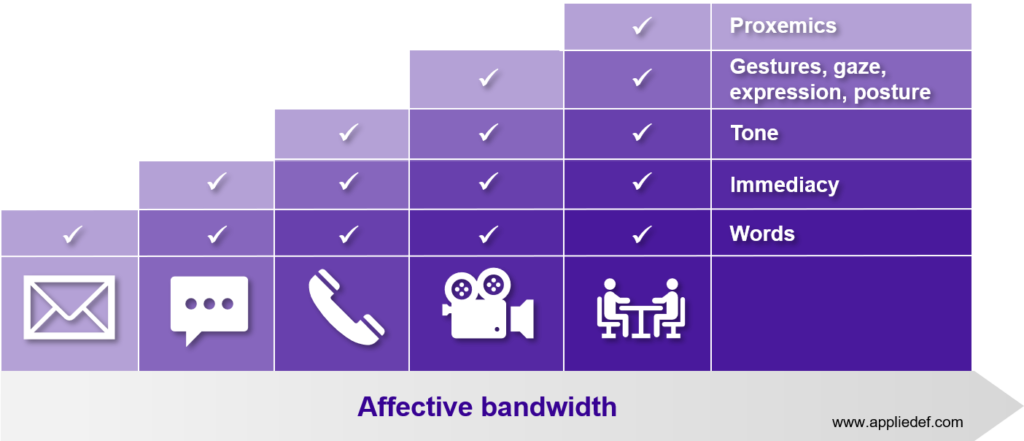Another factor of the remote working environment is how we maintain effective communication. For financial advisers, this is more important than ever. Clients are unsettled. They’re worried about their portfolios and their financial futures. This is a time when financial advisers need to connect with their clients, need to be attuned to the emotions that they’re experiencing and need to communicate effectively with them to help address these emotions.
We can usually do this through the medium of empathy. Effective empathy is about accurately understanding another person’s situation, and importantly, being able to demonstrate this understanding back to them. But this is easier said than done in the current environment where advisers can’t maintain face-to-face relationships with clients. Remote working and remote communication introduce a barrier to how easily we can connect with others.
So how can financial advisers instil empathy in a remote working environment?
Communication channels
As we know, communication relates to more than simply the words that are used. Gestures, facial expressions, the tonality in our voice, posture, eye gaze, the immediacy of our response and even the distance away from the other person (known as proxemics) all contribute to communication. By utilising more of these signals, we increase the level of information that gets through in our communication. This helps us to both achieve a greater level of understanding about our communication partner, as well as more accurately conveying our intended emotions to that partner.
This concept has been termed ‘affective bandwidth’ [1]. In essence, this is the capacity for different communication channels to allow different levels of ‘affective’ (or emotion-provoking) information to be received. A higher affective bandwidth (for example in a face-to-face interaction) can often allow more senses to be involved and more emotion to be interpreted.
Let’s consider the diagram below. In standard text communication, words and punctuation are the only tools at our disposal. This is why messages can often be misinterpreted via email. It can be particularly difficult to identify sarcasm or humour through this medium, as we are unable to balance the literal meaning of written text with expression or tone.

To the right of the ‘affective bandwidth’ spectrum shown in the diagram, the communication experience becomes more complex. In a face-to-face environment, all our communication signals count. We may be saying supportive words, and perhaps speaking in a comforting tone, but if our posture is dismissive and our eyes are looking elsewhere, the other party is unlikely to interpret our communication in a positive way.
So what are the implications of this for advisers? Here are two practical tips that advisers can use in their client communications:
1. Use the right communication channel for the situation.
We’ve already discussed how text communications may be misinterpreted; something you’ve likely experienced first-hand. Research has argued that emails are also often perceived to be less positive than the sender may have intended [2]. The lack of feedback in email communication, which we usually observe through subtleties of expression, such as a blank stare or rolled eyes, also mean that we may not be aware of how the recipient has perceived our message.
In the present environment, where advisers must be particularly attentive to their clients’ emotions, these minor misperceptions can have a significant impact. When sensitive messages, such as poor investment performance information, need to be delivered, advisers should consider which communication channel is best. If we want to provide a supportive environment for clients and be able to acknowledge their feedback, we should seek to leverage channels with a higher affective bandwidth.
The compromise between scalability of a certain channel, such as email communication, should be carefully considered against its communication intention. Are you able to use a channel higher on the affective bandwidth spectrum?
2. Compensate for non-verbal limitations.
It will not be practical to use video conferencing to replace face-to-face client meetings in all situations. Some firms may not have the infrastructure or processes in place to use this channel at all. Therefore, where advisers are limited in the use of non-verbal signals (such as expression, gestures or posture), proactive efforts must be made to ensure that communication is both empathetic and not misinterpreted.
If we are unable to observe a client’s non-verbal cues, then advisers must gauge their emotions and their response to information through other means. Simple coaching techniques, such as asking open questions (usually starting with ‘how’ or ‘what’) are a vital tool at the advisers’ disposal. We must be direct in requests for feedback and question whether our message could be perceived in a way that may not have been intended.
When communicating by phone, we are able to leverage tone of voice, cadence and immediacy of response to convey (and perceive) meaning. Advisers should use these signals purposefully. Be aware of your own style, particularly when you may be using a channel that you are not necessarily comfortable with.
If you cannot rely on non-verbal cues, you must communicate your intended signals directly. For example, if you would usually nod your head and exhibit an open posture to let your client know that you are listening, you must replace these subtle cues verbally, or explicitly stated in text.
3. Bonus tip: Maximise the affective bandwidth of video conferencing.
If you witnessed my family attempt a group Facetime conversation, you’d likely see at least someone with their camera round the wrong way, someone with their finger over the lens and you’d be looking up the nostrils of another. Hopefully, most people using video conferencing in a work environment have finessed their techniques a little better.
However, one of the simple tips that is often overlooked is the amount of the frame that we fill. Usually, the distance of people’s cameras is dictated by their usual position relative to their computer, which tends to result in a head and shoulders view of the other party. This negates some of the tools available to help us communicate effectively.
By filling the frame with our head and shoulders, the recipient cannot see our hand gestures or our posture – both useful non-verbal signals. The remedy is simple; by moving slightly further away from the camera and displaying our whole upper body, we make use of most of the communication signals at our disposal. You may wish to invest in a lapel mic if this causes sound issues.
This technique has actually been tested in a laboratory setting and the upper body frame was found to have a greater positive impact on perceived empathy than the common head and shoulders frame [3]. A simple tweak like this can have a dramatic impact on the emotional response of the other party.
Conclusion
In uncertain times like this, it’s vital that advisers build and maintain empathetic relationships with their clients. However, we must acknowledge the limitations of our communication options in a remote working environment and take actions to overcome them in order to achieve this. Successful advisers will find ways to bridge the communication gap that remote working has created.
Sources:
[1]: Amparo Lasén, “Mobile Media and Affectivity: Some Thoughts about the notion of Affective Bandwidth”
[2]: K. Byron, “Carrying too heavy a load? The communication and miscommunication of emotion by email”
[3]: David Nguyen and John Canny, “More than Face-to-Face: Empathy Effects of Video Framing”

